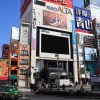You’ll never see these four hiragana on license plates, but maybe not for the reasons you’d expect….
License plates may not be the most exciting things on Earth, but the rules and regulations that go into them do have some interesting exceptions. For example the vanity plate “ILVTOFU” is banned in many states in the U.S. even though some people just want to express their love of tofu, as is “370H55V” for spelling out a not-so-nice word when read backwards and upside down.
And Japan has its own license plate exceptions too. Vanity plates are not really a thing in Japan, leading to most license plates having the same basic structure: the issuing office, a hiragana, and then some numbers.
▼ A license plate from Sendai with the hiragana “a” followed by the numbers 20-19.
図柄入り東京オリンピック パラリンピック記念ナンバープレートを導入! https://t.co/ZSE5ZS5jHb pic.twitter.com/tFNZK0kIp2
— MagX(ニューモデルマガジンX) (@CyberMagazineX) December 13, 2016
The usage of hiragana on license plates is unique to Japan, though out of all possible hiragana that could be used, there are some that never appear on license plates. They are:
1) Any hiragana with ten-ten voicing marks on the side (such as が (ga), じ (ji), ど (do) etc.)
2) Combination hiragana sounds (such as きゃ (kya), ちょ (cho), みゅ (myu) etc.)
3) Old hiragana not used anymore (such a ゐ (wi) and ゑ (we) etc.)
4) わ (wa) and れ (re) are only used on rental cars.
That still leaves a bunch of hiragana left over that can be used, but among them there are four which – for various reasons – are not allowed to be used on license plates. They are:
1) お (o). This one isn’t used because of its similarity to the hiragana あ (a). During a high-speed chase, the last thing police want to do is have to squint and try to deduce if they’re tailing an お or an あ only to get it wrong. This might also be why the similar-looking わ and れ are both only used for rental cars too.
2) し (shi). し isn’t used because it’s pronounced the same as the word 死 (“death”), making it an unlucky hiragana to have. Those who have studied Japanese know that the number four (also pronounced the same) is considered an unlucky number, similar to 13 in the West. But still, there are plenty of license plates with 13 in Western countries, and their owners haven’t all faced untimely deaths… probably.
3) ん (n). This one kind of makes sense, seeing as ん is the only hiragana that is just a consonant and not a consonant followed by a vowel. There are no words in Japanese that start with ん making it difficult to pronounce on its own. When department store clerks announce over the loudspeaker that a car has its lights on in the parking lot, they want to be able to get that info out clearly, not stumble over pronunciation errors.
4) へ (he). And here we have the strangest exclusion of them all. The reason you’ll never see a へ on a license plate? Because it sounds the same as 屁 (“fart”). We assume that policemen and store clerks would just burst into a fit of non-stop giggling if they had to read a license plate with へ on it, which led to its banning. Although perhaps the even funnier image is a room full of policy-makers deciding which hiragana are okay to use on license plates actually discussing the fact that へ makes them think of farts and striking it down because of that.
Thinking about it, it’s unfortunate that some hiragana are banned because of their similarity to other words. Personally I know that I would love to have an Evangelion license plate with し (“death”) on it, or a cute little farmer and cow license plate with へ (“fart”) on it just for giggles.
Source: livedoor NEWS via Hachima Kiko
References: Wikipedia
Featured image: Twitter/@CyberMagazineX

 Get ready for yuru-kyara car plates! Japan to lift ban on colourful regional license plates
Get ready for yuru-kyara car plates! Japan to lift ban on colourful regional license plates Learn Japanese through ridiculous manga: A Tick on Titan 【Episode #3】
Learn Japanese through ridiculous manga: A Tick on Titan 【Episode #3】 Japanese writing system gets turned into handsome anime men with Hiragana Boys video game
Japanese writing system gets turned into handsome anime men with Hiragana Boys video game 17 new designs unveiled in round two of regional Japanese license plates
17 new designs unveiled in round two of regional Japanese license plates In Japan, you can now get issued an official license plate with adorable cat prints on it
In Japan, you can now get issued an official license plate with adorable cat prints on it McDonald’s new Happy Meals offer up cute and practical Sanrio lifestyle goods
McDonald’s new Happy Meals offer up cute and practical Sanrio lifestyle goods Studio Ghibli releases new action figures featuring Nausicaä of the Valley of the Wind characters
Studio Ghibli releases new action figures featuring Nausicaä of the Valley of the Wind characters Super Nintendo World expansion gets delayed for several months at Universal Studios Japan
Super Nintendo World expansion gets delayed for several months at Universal Studios Japan All-you-can-drink Starbucks and amazing views part of Tokyo’s new 170 meter-high sky lounge
All-you-can-drink Starbucks and amazing views part of Tokyo’s new 170 meter-high sky lounge Katsudon vs. tonkatsu vs. katsu sandwich – What’s the best way to eat pork cutlet in Japan?
Katsudon vs. tonkatsu vs. katsu sandwich – What’s the best way to eat pork cutlet in Japan? Studio Ghibli glasses cases let anime characters keep an eye on your spectacles
Studio Ghibli glasses cases let anime characters keep an eye on your spectacles Arrest proves a common Japanese saying about apologies and police
Arrest proves a common Japanese saying about apologies and police More foreign tourists than ever before in history visited Japan last month
More foreign tourists than ever before in history visited Japan last month Ghibli action figures bring Nausicaä of the Valley of the Wind soldiers to life in 3-D form
Ghibli action figures bring Nausicaä of the Valley of the Wind soldiers to life in 3-D form Hamster abandoned at Tokyo ramen restaurant gets new home
Hamster abandoned at Tokyo ramen restaurant gets new home Disney princesses get official manga makeovers for Manga Princess Cafe opening in Tokyo
Disney princesses get official manga makeovers for Manga Princess Cafe opening in Tokyo Starbucks reopens at Shibuya Scramble Crossing with new look and design concept
Starbucks reopens at Shibuya Scramble Crossing with new look and design concept Beautiful new Final Fantasy T-shirt collection on the way from Uniqlo【Photos】
Beautiful new Final Fantasy T-shirt collection on the way from Uniqlo【Photos】 Is the new Shinkansen Train Desk ticket worth it?
Is the new Shinkansen Train Desk ticket worth it? Foreign English teachers in Japan pick their favorite Japanese-language phrases【Survey】
Foreign English teachers in Japan pick their favorite Japanese-language phrases【Survey】 Beautiful Sailor Moon manhole cover coasters being given out for free by Tokyo tourist center
Beautiful Sailor Moon manhole cover coasters being given out for free by Tokyo tourist center Studio Ghibli releases Kiki’s Delivery Service chocolate cake pouches in Japan
Studio Ghibli releases Kiki’s Delivery Service chocolate cake pouches in Japan Japan’s bone-breaking and record-breaking roller coaster is permanently shutting down
Japan’s bone-breaking and record-breaking roller coaster is permanently shutting down New definition of “Japanese whiskey” goes into effect to prevent fakes from fooling overseas buyers
New definition of “Japanese whiskey” goes into effect to prevent fakes from fooling overseas buyers Our Japanese reporter visits Costco in the U.S., finds super American and very Japanese things
Our Japanese reporter visits Costco in the U.S., finds super American and very Japanese things Studio Ghibli unveils Mother’s Day gift set that captures the love in My Neighbour Totoro
Studio Ghibli unveils Mother’s Day gift set that captures the love in My Neighbour Totoro Domino’s Japan now sells…pizza ears?
Domino’s Japan now sells…pizza ears? New Japanese KitKat flavour stars Sanrio characters, including Hello Kitty
New Japanese KitKat flavour stars Sanrio characters, including Hello Kitty One of Tokyo’s most famous meeting-spot landmarks is closing for good
One of Tokyo’s most famous meeting-spot landmarks is closing for good Kyoto creates new for-tourist buses to address overtourism with higher prices, faster rides
Kyoto creates new for-tourist buses to address overtourism with higher prices, faster rides Sales of Japan’s most convenient train ticket/shopping payment cards suspended indefinitely
Sales of Japan’s most convenient train ticket/shopping payment cards suspended indefinitely Sold-out Studio Ghibli desktop humidifiers are back so Totoro can help you through the dry season
Sold-out Studio Ghibli desktop humidifiers are back so Totoro can help you through the dry season Japanese government to make first change to romanization spelling rules since the 1950s
Japanese government to make first change to romanization spelling rules since the 1950s Ghibli founders Toshio Suzuki and Hayao Miyazaki contribute to Japanese whisky Totoro label design
Ghibli founders Toshio Suzuki and Hayao Miyazaki contribute to Japanese whisky Totoro label design Doraemon found buried at sea as scene from 1993 anime becomes real life【Photos】
Doraemon found buried at sea as scene from 1993 anime becomes real life【Photos】 Tokyo’s most famous Starbucks is closed
Tokyo’s most famous Starbucks is closed One Piece characters’ nationalities revealed, but fans have mixed opinions
One Piece characters’ nationalities revealed, but fans have mixed opinions We asked a Uniqlo employee what four things we should buy and their suggestions didn’t disappoint
We asked a Uniqlo employee what four things we should buy and their suggestions didn’t disappoint Princesses, fruits, and blacksmiths: Study reveals the 30 most unusual family names in Japan
Princesses, fruits, and blacksmiths: Study reveals the 30 most unusual family names in Japan World’s first moaning hiragana character either a stroke of genius or just plain weird【Video】
World’s first moaning hiragana character either a stroke of genius or just plain weird【Video】 Japanese first grader wins math contest by quantifying “which hiragana are the hardest to write”
Japanese first grader wins math contest by quantifying “which hiragana are the hardest to write” Learn Japanese through ridiculous manga: Death Vote 【Episode #6】
Learn Japanese through ridiculous manga: Death Vote 【Episode #6】 Cherry blossoms are going to bloom on Tokyo’s new license plates
Cherry blossoms are going to bloom on Tokyo’s new license plates “We wasted so much time in English class” — Japanese Twitter user points out major teaching flaw
“We wasted so much time in English class” — Japanese Twitter user points out major teaching flaw Sayonara, crossbows – Police ask owners to turn in their crossbows as new ban goes into effect
Sayonara, crossbows – Police ask owners to turn in their crossbows as new ban goes into effect Japan’s handsome, buff Swedish gardener now has a new job: Working out silently on public TV
Japan’s handsome, buff Swedish gardener now has a new job: Working out silently on public TV Japan has too many adorable Akita dog license plate designs, needs help picking just one
Japan has too many adorable Akita dog license plate designs, needs help picking just one Struggling with Japanese? Let Tako lend you a hand…or five
Struggling with Japanese? Let Tako lend you a hand…or five Video of each Japanese hiragana getting “measured up” is oddly cute and satisfying【Video】
Video of each Japanese hiragana getting “measured up” is oddly cute and satisfying【Video】 Only one out of five Japanese people can pronounce these hiragana — can you?
Only one out of five Japanese people can pronounce these hiragana — can you? City in Nagano offers super cheap taxi fares to seniors who give up licenses and disabled people
City in Nagano offers super cheap taxi fares to seniors who give up licenses and disabled people Learn Japanese through ridiculous manga: Narutoe 【Episode #2】
Learn Japanese through ridiculous manga: Narutoe 【Episode #2】 Japanese elementary school student teaches us all how to pronounce English like a native speaker
Japanese elementary school student teaches us all how to pronounce English like a native speaker Make your business memorable with a license plate phone number
Make your business memorable with a license plate phone number Foreigners in Japan vote for the best-looking katakana character
Foreigners in Japan vote for the best-looking katakana character
Leave a Reply